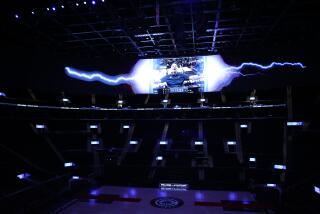With CourtVision, fans get an early look at the future of NBA basketball
Every Wednesday morning, a dozen or so coworkers from the analytics firm Second Spectrum play co-ed pickup basketball on the court inside the Alpine Recreation Center downtown.
The games used to be slow paced, even instructional, but those days are long gone. The company has grown and so has the competition. Rent is paid for the space and the games are replete with many of the staples seen in any NBA game — dribble drives to the basket and three-pointers from the corners.
After, the players pack into cars and traverse the little more than a mile to their office in Little Tokyo, where they pivot to a different passion — working to forever change the way basketball and other sports are broadcast, watched and understood.
A few of them report to a part of the company that provides advanced analytics to the NBA, such as how efficiently a player shoots based on location and circumstance, using motion-tracking software that helped launch the business six years ago. Others work on what the firm believes will be the next big thing — allowing fans to tailor their viewing experience just the way they’d like, whether watching at the game, on television or on a mobile device.
It’s not a far-off fantasy. Since the technology was unveiled publicly at the start of the NBA regular season, Clippers CourtVision has allowed Fox Sports’ Prime Ticket customers to go beyond the traditional team broadcast by choosing their own camera angles, audio feeds and whether they want to view the game from the perspective of a coach or player.
“This,” Second Spectrum CEO Rajiv Maheswaran predicted, “is fundamentally how everyone is going to watch sports.”
In the last four months, Clippers owner Steve Ballmer and other investors have been emboldened by the reception of CourtVision from fans, media, tech companies, the NBA and television executives. Already, CourtVision has won a league award for innovation and drawn attention from several teams interested in incorporating the technology into their own broadcasts.
“I can’t say I’m more bullish,” Ballmer said during a recent interview, “because I was so damn bullish.”
Said Maheswaran: “We’re showing not [just] what is possible, but what is clearly coming.”

::
A decade ago, when Ballmer was Microsoft’s CEO, he chased ways to use the internet to improve the viewing experience of movies, video games and sports by making it more interactive.
He quickly ran into dead ends. Hollywood producers pushed back on allowing viewers to choose the ending of their stories. The technology wasn’t fully capable either. Streaming huge amounts of video for customers was difficult.
The idea stayed with Ballmer but didn’t intensify until 2014 when he discovered Second Spectrum, a year-old start-up largely conceived in the offices of the Computational Behavior Group at USC.
The fledgling company had already established credibility within basketball circles by using cameras and motion-tracking software to produce advanced analytics. NBA teams quickly signed on. Coach Doc Rivers’ Clippers staff was the first to meet with Maheswaran and a handful of colleagues.
“Coaches used to yell at us like, ‘Get the ball over the court this way, because I said so,’” Maheswaran recalled one player telling him. “Versus, ‘Do this because now it’s X-percent more efficient.’”
Rivers used the new technology to nudge players out of taking low-percentage shots. “When a player sees a guy shooting and it says 20%,” the coach said, “that locks in far more than seeing it on a piece of paper.”
Ballmer bought the Clippers in August 2014 and within a month was at Second Spectrum’s office to watch a demonstration of motion-tracking software.
That led to an A-ha! moment: Could this help build an interactive viewing experience for fans too?
“He was like, ‘Wow, can you imagine if you could put that in the hands of the consumer?’” recalled Gillian Zucker, the Clippers’ president of business operations.
Ballmer became both an investor in and client of Second Spectrum, urging the firm to not only change how fans watched Clippers games — whether on television, or the internet — but also what they watched. Both the company and Ballmer wanted graphics and animation to amplify in real-time the action taking place on the screen, much like how the computer-generated yellow first-down marker, first used in 1998, added a new dimension to football broadcasts.
By Ballmer’s first home game as owner in October 2014, fans at Staples Center were watching highlight packages on the arena scoreboard that used augmented reality to highlight why a certain play succeeded.
For Second Spectrum, it was a first step toward developing CourtVision.
Two years later, the company won a contract with the NBA to provide advanced statistics using player-tracking software. Twenty-eight of the league’s 30 teams have subscribed to receive customized analytics. Some of the information — measuring a player’s touches, speed, distance run and more — are available to the public online.
The company believes its success is due not just to its passion for technology, but also basketball. Several of its more than 100 employees played in college at MIT. Another played professionally overseas.
“Loving and knowing and understanding sports helps you make better products,” Maheswaran said. “It definitely helps when you’re talking about how to build a shot-probability model, when you’ve got a bunch of MIT basketball captains arguing over it.”
::
Six minutes and 47 seconds remained in the Clippers’ Feb. 9 game in Boston when reserve guard Lou Williams took a pass just short of half court, dribbled the ball twice, and bounced a pass into the corner, where teammate Landry Shamet waited beyond the three-point arc.
As the action unfolded, six cameras mounted in the rafters of TD Garden captured the movement of every player and the ball, feeding the data into software designed to make sense of what was taking place. At the same time, graphics were automatically generated and laid over the video.
While Shamet waited to catch Williams’ pass, fans watching on CourtVision’s Player Mode saw rapidly changing numbers floating above the player’s head — his expected shooting percentage from the location, based on the rookie’s brief NBA history. When his shot went up, the number stuck at 30%.
He beat the odds. Shamet’s shot tied the score at 100 and capped a 28-point comeback, the largest in Clippers franchise history.
As the ball ripped through the net, fans listening to Prime Ticket’s audio feed through CourtVision heard broadcaster Ralph Lawler’s voice nearly break in excitement: “Bingo!” he shouted.
Some of the hardest work during the past four years has been spent cutting down the lag time between the action and when it is seen through CourtVision. In the fall of 2017, the latency was 45 minutes. It was two minutes at the start of this season, and 10-15 seconds have been shaved off since. The goal, Ballmer said, is to match the latency of a traditional broadcast — about 10-20 seconds. But that takes a huge amount of processing power.
CourtVision is processed through Amazon Web Services’ cloud. Ballmer, who led Microsoft’s push into cloud computing through its own service, raised the possibility of using rival Microsoft with Second Spectrum leaders about two years ago, he said, but didn’t intervene in the decision.
“Cut me open, all you’re going to find is Microsoft inside,” Ballmer said, “and yet at the same time, this is a great partnership.”
CourtVision is accessible to Prime Ticket subscribers online and through the Fox Sports app, and allows fans to choose their preferred view. The options are:
Traditional Broadcast, which is what you typically see on television;
Coach Mode, which diagrams plays and players’ movement with graphics and has been most popular so far;
Player Mode, which shows the probability of making a shot based on location and statistics;
Mascot Mode, which sprinkles light-hearted animation into the game.
The company says about a thousand users have tried CourtVision this season. Fans viewing on their phones have watched for an average of about a half-hour per game this season; the average for other viewers is about an hour and 15 minutes.
“The feedback from people who use the product is so overwhelmingly positive it’s almost like we could fool ourselves that there’s not a lot more work to do,” Ballmer said.
Amy Brooks, the NBA’s chief innovation officer and president of team marketing and business operations, said CourtVision’s interactivity has been monitored closely by league executives trying to grow the NBA’s fan base overseas.
“The personalization has a lot of potential and it’s very creative,” she said. “We see it as a great test.”
::
What the future of sports viewing looks like no one is quite sure. Ballmer predicted CourtVision-style viewing could become the norm inside of five years. More than perfecting the technology itself, the challenge will be to untangle the web of broadcasting rights and distribution for teams and leagues.
This year, CourtVision’s modes are essentially additional channels for Fox’s broadcast. In the future, when the Clippers’ rights are up for bidding, CourtVision could be sold directly to consumers who have cut the cord on a cable subscription.
“It’s not clear where that business model will shake out,” Ballmer said. “We have some time as the product gets better and better.”
Ballmer is most excited about a new viewing mode that is being developed.
Dubbed “Pick&Roll,” it will allow users to select and switch players at any point during a play, accruing points as they score, set screens, rebound and defend. Points flash above a player’s head like video game graphics. A scoreboard of everyone using the mode is updated in real time.
It’s a new take on fantasy sports, and predicts a future in which gambling becomes legal and integrated into professional sports leagues.
“You can imagine that if gambling was ever legal, it’s basically a similar thing,” Ballmer said. “Points can be currency.”
How soon that mode might be available has not been determined. And the technology has potential for advertisers too. Imagine, Zucker said, tracks sponsored by a tire company tracing a player’s drive toward the basket.
What’s next after that is, for now, entirely left to the imagination. Yet, for several of the company’s employees, work gets set aside every Wednesday from 6 to 8 a.m. when they lace up their sneakers for a game.
While none of them is good enough at basketball to consider leaving their day job, a team representing Second Spectrum has won TechJam, a charity tournament between L.A.-area tech firms, four years running.
And, just like the pros, last summer’s title run was captured by cameras tracking every dribble, pass and shot.
Sign up for our daily sports newsletter »
Twitter: @andrewgreif
More to Read
Go beyond the scoreboard
Get the latest on L.A.'s teams in the daily Sports Report newsletter.
You may occasionally receive promotional content from the Los Angeles Times.











